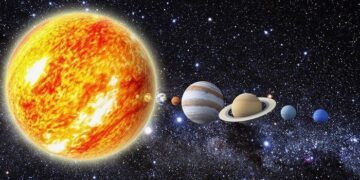Mars is one of the planets we can sometimes see from Earth with our naked eye.
Here are the top interesting facts about the planet Mars.
Mars is considered the most likely planet in our Solar System to have had conditions suitable for life at some point.
The Martian day, or “sol,” is approximately 24 hours, 39 minutes, and 35 seconds.
Mars has polar caps like Earth, containing frozen carbon dioxide and a small amount of water, too.
Mars once had flowing water, and it’s possible it may have had a blue sky in its early history.
Mars has seasons like Earth. This is caused by the tilt of the planet’s axis, which is at a similar angle to the tilt of Earth’s axis.
The tilt of Mars’ axis is 25.19°.
From Mars, the Sun looks roughly two-thirds the size it does from Earth.
Rocks from Mars have landed on Earth, carried by meteorites from Martian asteroid impacts.
The planet Mars was named after the Roman God of War because its color resembles blood.
In Greek, Mars was known as Ares.
Roughly half of all missions to Mars have been successful.
Mars has its own holiday, Red Planet Day, which is celebrated on November 28.
Mars may have once been capable of sustaining life, but it lost its atmosphere long ago, making it unable to support life today.
The ancient Romans, Ancient Egyptians, and Babylonians made significant observations of Mars, recognizing it as a distinct planet and tracking its movements across the night sky
Mars is called the “Red Planet” because of its red color. The reason Mars is red is that it has iron oxide on its surface, which we commonly know as rust.
Mars’ crust is estimated to be between 12 miles (20 km) and 43 miles (70 km) thick, which is similar to Earth’s continental crust.
Mars experiences frequent dust storms due to its thin atmosphere, which can cause surface erosion over time.
Mars is roughly 141 million miles (227 million km) away from the Sun.
Unlike Earth, Mars has minimal protection from ultraviolet radiation because it lacks a significant atmosphere and ozone layer.
Martian temperatures can vary from -125°C at night to 20°C during the day near the equator.
Mars’s volume is approximately 15% that of Earth, and its density is 3.933 grams/cubic centimeter.
Less mass suggests that Mars’ gravity is also less than Earth’s. This suggests that a person or object that is 100 pounds on Earth will likely weigh 38 pounds on Mars.
If the Statue of Liberty was built on Mars identically to the one on Earth it would weigh 85,500 kg less than it does on Earth.
Mars has about a third of the Earth’s gravity, which means that you can jump three times as high.
There are 687 Earth days in a Mars year.
The seasons on Mars are similar to Earth’s seasons, except that they are twice as long. This means Mars has a yearly cycle that humans could understand and adapt to.
Mars is seen as a better place to look for signs of past life than Venus because Venus is too hot and has conditions that make it hard for life to survive.
In the 1970s, the Viking orbiter took pictures of rock features on Mars that looked like giant faces and pyramids carved into the planet’s surface.
Mars has some of the wildest weather in the solar system. It has tremendous wind storms, dust storms, and small tornadoes.
In 2001, a huge dust storm covered the entire planet for several Earth days.
There are more storms on Mars when the planet is closer to the Sun.
Mars has two small moons named Phobos and Deimos.
The moon Phobos orbits extremely close to Mars’ atmosphere. This means that one day, the gravitational pull with smash the moon to bits. The debris will stay in Mars’ orbit, which will form a ring-like the rings of Saturn.
Phobos and Deimos are named after the mythological sons of Ares, the god of war.
On November 13, 1971, the Mariner 9 reached Mars and officially became the first artificial satellite to orbit Mars.
Mariner 9 mapped 85% of Mars’ surface and took the first close-up images of Phobos and Deimos.
In total, Mariner 9 took 7,329 photos of Mars and stayed in orbit for 349 days.
In 1976, NASA’s Viking 1 and 2 became the first spacecraft to successfully land on Mars.
Though Viking 1 and 2 weren’t the first to photograph Mars, their mission aimed to explore the mysteries behind the craters and valleys previously revealed, searching for signs of life.
Launched on November 7, 1996, Mars Global Surveyor was the first successful Mars mission in 20 years.
Mars Global Surveyor took over 240,000 pictures of Mars during its mission.
If you tried to stand out on the surface of Mars without a spacesuit, you would die almost immediately.
Mars is the 4th planet from the Sun and the 7th largest planet.
The largest volcano in the Solar System is on Mars. It is called Olympus Mons, which is Latin for Mount Olympus.
Olympus Mons is 16.7 miles (27 km) high, 373 miles (600 km) wide, and 5.5 miles (8.85 km) taller than Mount Everest.
Olympus Mons is a shield volcano, meaning it grew bigger and bigger due to the lava flows during eruptions.
Like Mars, the month of March was named after the Roman god of war.
Mars’ moons were discovered by an American astronomer named Asaph Hall in 1877.
The diameter of Mars is roughly 4,220 miles (6,791 km).
The first spacecraft to visit Mars was Mariner 4 in 1965.
A Martian year is equal to 1 Earth year, 320 days, and 18.2 hours.
In November 2011, NASA launched the Curiosity rover, a more advanced version of previous Mars rovers. It landed in 2012.
Over 15,000 (6,800 kg) pounds of human trash has been left on Mars from all of our missions there.
It was once thought that an alien skull was found on Mars.
Mars is roughly 1.5 times farther from the Sun than Earth, at about 1.52 AU (astronomical units).

















